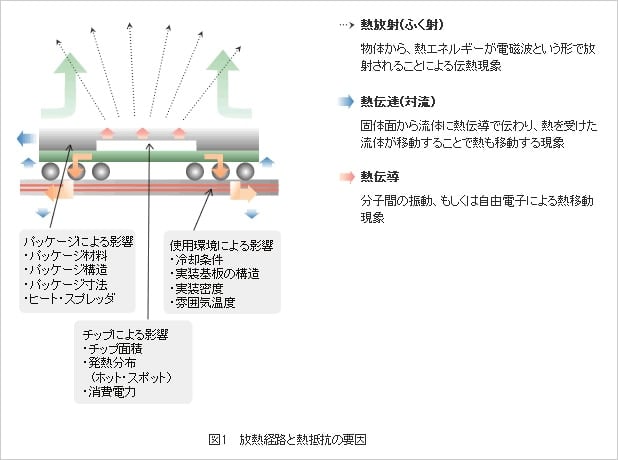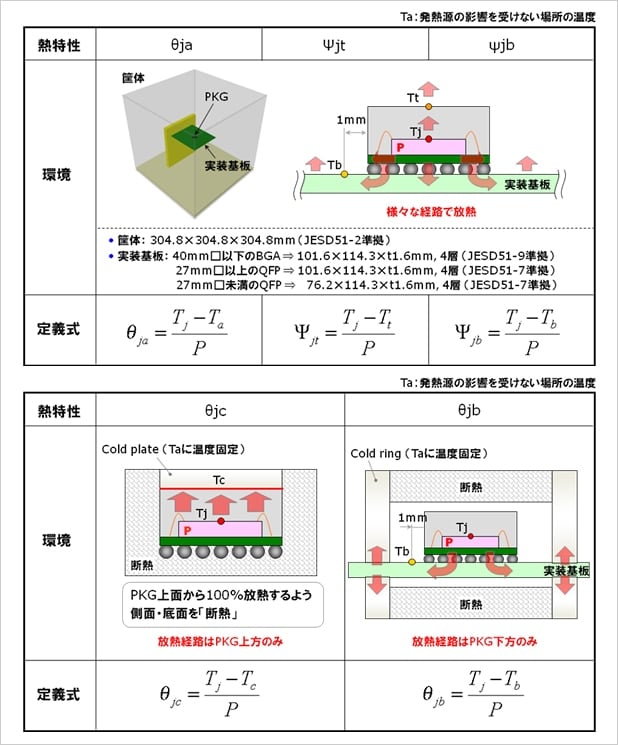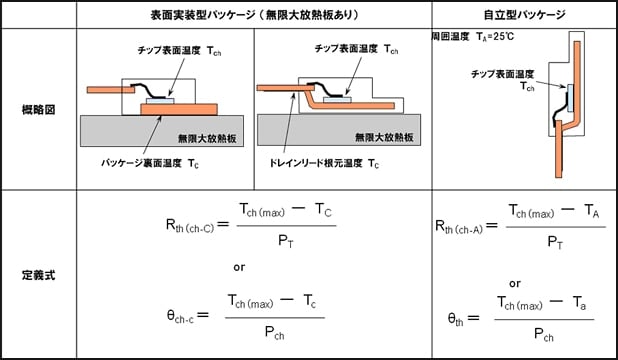まず、1つめの解決すべきテーマとなるのが半導体デバイスで発生する熱への対策です。 対策の前提となる放熱の仕組みから見ていくことにしましょう。
発熱
発熱は安全性、信頼性、性能に悪影響を及ぼす
電気回路の中にある「抵抗」に電流が流れると熱が発生します。 半導体デバイスも一種の抵抗と見なすことができ、電流が流れると、オン抵抗(電気を流したときの内部抵抗)に応じた熱を発生することになります。 熱は、半導体デバイスそのものに対してはもちろん、それを組み込んだ電子機器にもさまざまな悪影響を及ぼすことがあります。中でも安全性と性能、そして信頼性への影響に注意する必要があります。 安全面では、デバイスで想定以上の発熱があると、電子機器から煙が出たり、発火したりする危険が高まります。性能の面では熱によってデバイスの動作スピードが低下したり、最悪の場合、破壊につながり、動作不良に陥るケースも発生します。これほどひどくない場合でも、デバイスの故障頻度を増やし、電子機器の寿命を縮めることもあります。 こうした熱による悪影響を回避するために、半導体パッケージの熱対策が不可欠になっています。
放熱は熱伝導、熱伝達(対流)、熱放射(ふく射)の3つのルートで行われる
熱対策を検討するうえで、まず理解しておくべき基本は、半導体デバイスが発生した熱をどのように逃がすかという、放熱のメカニズムです。 一般に熱は、熱伝導、熱伝達(対流)、熱放射(ふく射)という3つの方法で伝わります。こうした放熱の様子を、プリント基板や空気などを含めた実際の使用環境に即して検討してみると、熱は熱源となるチップから図1のような流れで、最終的な熱の放出先となる空気へと伝わっていきます。

プリント基板を介した放熱が大部分を占める
こうした放熱のメカニズムのうち、熱放射については、パッケージの表面積が非常に大きいケース、以外では無視できるほど小さくなります。したがって、パッケージからの実際の放熱は、
- パッケージ表面の上部から空気に熱伝達する経路
- 外部端子からプリント基板に熱伝導し、プリント基板から空気へと熱伝達する経路
- パッケージ側面へ放熱する経路
の3つがあることが分かります。(図2参照)

Oデバイスを基板実装したのみで、パッケージ上面にヒートシンクを装着していない場合では、最大の放熱経路はプリント基板への熱伝導になります。計算によると、全体の8割を占めています。実際に熱流体解析を行うと、352ピンPBGAを4層基板に実装した状態で、9割がプリント基板経由、パッケージ表面からの放熱はわずかに1割という結果も出ています。
IC系 熱特性定義
ICの熱抵抗と熱特性パラメータの定義
熱抵抗の測定方法とその定義をJEDEC規定に基づいて説明いたします。

図3 熱抵抗と熱特性パラメータの定義
| θj | θjaはパッケージがPWBに実装されているときのチップの接合部温度と周囲温度との間の熱抵抗です。 自然対流または強制対流が測定条件に適用されます。 θjaは、さまざまなパッケージ間の熱性能を比較するために使用されます。 |
|---|---|
| Ψjt, Ψjb | Ψjtは、チップの接合部(Tj)とパッケージ上面の中心(Tt)との間の温度差を示すデバイスの総消費電力(P)に対する熱特性パラメータです。 Ψjbは、デバイスの総消費電力(P)に対する熱特性パラメータであり、パッケージ(Tb)に近いチップ(Tj)とPWBの接合部間の温度差を示します。 ΨjtとΨjbを用いて、P、Tt、TbからTjを推定します。 |
| θjc, θjb | θjcは、全熱が接合部からパッケージ上面まで流れるときのTjとパッケージ表面温度(Tc)との間の熱抵抗です。 θjcは、2抵抗モデルで主に使用され、ほとんどの熱が接合部からパッケージ上面まで流れるときにTjを推定します。 θjbは、全熱が接合部からPWBに流れるときのTjとTbとの間の熱抵抗である。 θjbは2レジスタモデルに使用されます。 |
参照: JEDEC JESD51
注意:
- パッケージの熱特性値は搭載される周囲環境に大きく依存します。
- このため、JEDECでは特定の固定環境を定め、各熱抵抗値を定義しています。
- 放熱設計時には、実際に搭載されるセット環境を想定した上で、放熱施策を検討する必要があります。
- θjcについては、使用条件(ヒートシンク能力など)によっては過大見積もりになります。
ディスクリート系熱特性の定義
IC系の熱特性と比較しますと、パワーデバイスを含むディスクリートデバイスは放熱量が多く、定常状態とともに過渡熱抵抗が重視されます。

ディスクリートデバイスの熱パラメータの定義
| Symbol | Description | |
|---|---|---|
| 電力定格 | PT or Pch | 半導体素子に印加できる電力の上限値 パッケージの放熱特性でほぼ決まります。 |
| TC or Tc | パッケージ裏面中央部またはドレインリード根元部の温度 ※Cまたはc:case(ケース) | |
| TA or Ta | パッケージの周囲温度 ※Aまたはa:anbient(周囲) | |
| 温度定格 | Tch(max) | MOSFETのチャネル部(チップ)の上限温度通常にて規定 |
| Tstg | MOSFETを使用したセット、またはMOSFET単体等、保存する場合の許容温度範囲 | |
| 過度熱抵抗 | rth(t) | パルス上の電力損失時における、熱の電導度の逆数 |
| 定常熱抵抗 | Rth(ch-C) or θch-c | チャネル・ケース間の熱抵抗 |
| Rth(ch-A) or θth | チャネル・周囲間の熱抵抗 | |
| Rth(ch-C)や Rth(ch-A)がデータシートに記載されていない場合は、絶対最大定格(一瞬でも超えてはいけない定格)のPTおよびTch(max)より下記のように算出できます。
※製品によって記号は異なります。 | ||
図4 ディスクリート系熱特性の定義


